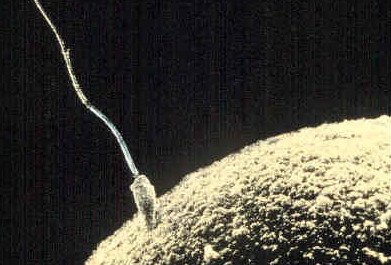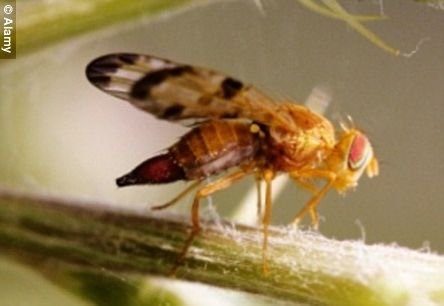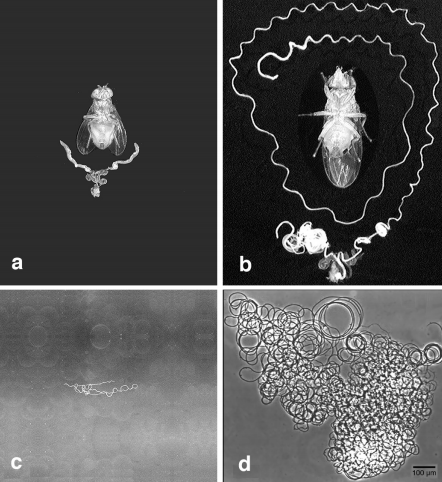My guess is that you probably know that sperm cells are generally really, really small. Small enough to not be visible with the human eye. For example, the sperm cells produced by humans "consist of a flat, disc shaped head 5.1 µm by 3.1 µm and a tail 50 µm long", making them about 0.005 cm long. [1]

A sperm cell fertilizing an egg cell (credit)
With that in mind, can you guess how big the world's longest sperm gets to be? And what animal actually produces it? The first time I wondered this myself, my guess was the blue whale (world's largest mammal to have ever existed) or some other big creature.
Turns out I couldn't be more wrong! The world's longest sperm is actually produced by this little guy:

Drosophila bifurca (credit)
The fly above is a fruit fly of the Drosophila bifurca species and holds the record for longest sperm cells produced by any known organism. How big? When fully uncoiled, the sperm cells of this fruit fly can reach an astonishing length of up to 5.8 cm long [2]!
To give you a perspective this is about 1,000 times longer than the average human sperm cell and more than two times the body length of the fly!
Interestingly, this sperm gigantism occurs in all Drosophila species, with the previous record holder being Drosophila hydei, which produces sperm cells that are about an inch long. [3]
The sperm cells produced by fruit flies are mostly tail and are delivered in the form of tangled coils that unravel once they enter the female reproductive tract. Not surprisingly, these flies also have huge testicles (compared to their body!) which make up almost 11 % of their total body weight! Obviously, the development of these huge sexual organs comes with a high energy cost:
"After molting into adults, they said, male flies must wait 17 days before they can reproduce, compared to only 7 days for females." [3]
Male fruitflies can only make a few hundred of these giant cells during their life, only about 800 [3]. Again, to give you an idea, a fertile male human ejaculates between 2 and 5 ml of semen, with each ml containing about 100 million sperms. [4]. And that's for just one ejaculation, obviously the number produced by a human during his entire lifetime is somewhere in the trillions! So for fruit flies I guess it's quality over quantity!
Why So Big?
Generally speaking, sperm cells are small because this way males can produce more of them. From an evolutionary aspect, small sperm increases the chances of successful fertilization, especially in species where females have multiple males. And drosophilia flies are a species like that.
So, we would expect from them to produce small sperm cells! Why this occurrs remained a mystery for many years and was dubbed as the "big sperm paradox."
However, a study published in 2016 came to solve this riddle. Apparently, in small species where the reproductive tract of females is small, it might be actually more beneficial to produce large sperm cells that block the way to other sperms from other males:
Specifically, longer sperm are superior at displacing, and resisting displacement by, shorter competitor sperm

Intact male fly above his reproductive tract (a, b) and a single spermatozoon (c, d) for Drosophila arizonae (a, c) and D. bifurca (b, d). Top panels and bottom panels depict equal magnification, respectively. (credit)
References & Further Reading
- Wikipedia.org/wiki/Spermatozoon
- Nature.com/articles/375109a0
- Nytimes.com/1995/05/11/us/when-it-comes-to-giant-sperm-this-tiny-fruit-fly-is-a-whale.html
- Oakland.edu/biology/lindemann/spermfacts.htm
- Nature.com/articles/nature18005
 More Strange Animals
More Strange Animals
If you enjoyed reading this post I am sure you will love some of my previous work:
- Meet The World's Strangest Ants
- The Squid With The Human-Like Teeth! (Promachoteuthis sulcus!)
- 4 Very Strange Animals I First Heard Of This Week
- Halloween Special: A Real-Life Monster Compilation
- Alien-Like Moth With Tentacles Terrifies The Internet - But Is This Creature Real?
- This Hummingbird Is Just So Weird! Can You Guess Why?
- This Deep Sea Creature Looks Like An Alien Spaceship
- World's Largest Millipede VS Smallest Millipede

